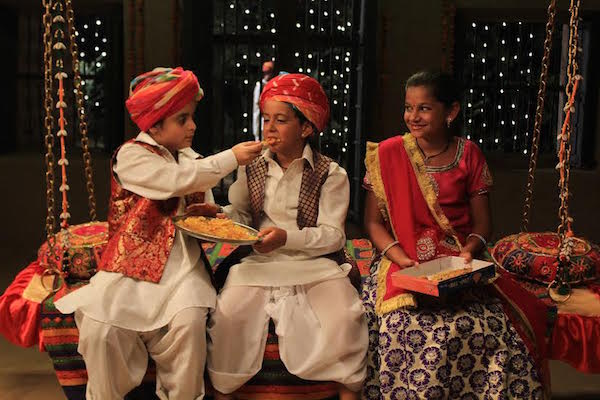No dearth of audience for children’s films in India: Manish
After supporting interesting films like Ankhon Dekhi, Masaan and Waiting, Drishyam Films headed by Manish Mundra is back with their latest release Dhanak. This Nagesh Kukunoor film revolves around a heartwarming story of two siblings and Manish promises it to be a film about goodness and love. We spoke with Manish about Dhanak, Drishyam Films and the overall scenario of small budget indie films.

Manish Mundra
What attracted you to Dhanak’s script? As a producer, how involved are you with the film?
When I met Nagesh (Kukunoor, director) he had narrated a couple of scripts to me. I wanted to make a film which speaks about goodness and love. When he spoke about Dhanak I instantly felt attracted to its plot which was based in Rajasthan. I have a special bond with Rajasthan. I run a school called ‘Society for Rational Development’ in Jodhpur. This school has more than 300 kids and more than 50 percent are girls. We teach them self-reliance, free of cost. All these beautiful kids kept reminding me of the story (of Dhanak) and I felt a connect. Nagesh also saw the school during our recce in Jodhpur. That’s when the real journey for the film began.
At Drishyam Films we have a professionally organised team. We line produce, budget and create our own films. As far as script is concerned, my role is just to absorb the script and its synopsis. If I like a story I take a decision of going ahead with the script. That’s my role. Other than that there is a team under Shiladitya Bora (CEO) and Raghav Gupta (Head of Production) who respectively manage the show at Drishyam. My role is very limited to selecting a script along with its team members and taking a call based on the budget required for the project. Yes, I do give my creative inputs, if any. But then at the end of the day our company’s philosophy is that the Director is the owner of the story and the film. We let his creative freedom unruffled. We can suggest and leave comments but the final call always remains with the director.
READ: DHANAK – A FILM WITH KIDS BUT NOT JUST FOR KIDS
It has been a long journey for Dhanak from various festivals to finally a theatrical release. Please talk about this route that smaller films take before getting a commercial release. Is it viable?
These films have content and so they travel. It is not that every small film has content. If your film is content-driven and does not have much of a star value, which film audiences are in awe of, you need the world to talk about your film and appreciate it. You need maximum eyeballs to make the film a talking point. Naturally, if the film is good and has traveled the world it helps the film when it returns home. When the world talks about your film, it’s release is awaited back home. This positive speaking environment in the audience is a very good proposition for the initial days of release.
Kids have their own world, which needs to be picturised and shown to the rest of the world
We do not have many films for and about children in India. Is it due to a lack of demand or lack of good stories? Would you want to support more children based scripts?
I am not in the position to answer that question as to why lesser number of films are being made about children. But I personally feel that there is a huge scope in this area. I don’t see any dearth of audience for such films.
Yes, whenever there is a story which touches my heart and is related to children I would love to do it. Because I feel that films where kids enact and talk about their feelings should be made. Kids have their own world, which needs to be picturised and shown to the rest of the world. We must learn to respect the world of the kids. So, certainly I would love to make a couple of more films on kids if I come across good stories.

Still from Dhanak
How do you plan PR and marketing strategies for your films? Dhanak being a content-driven film, don’t you think there should be a different way of promoting such films compared to typical Bollywood films?
As I have mentioned earlier these decisions are a prerogative of team Drishyam and not me alone. What we have experienced with Ankhon Dekhi, Masaan, Waiting and now Dhanak is that even if your film is content-driven you need to promote it as a typical star-studded masala film. At the end of the day you are competing with them. You don’t have a different world or live in solitude. You go there and compete in the film market with the same set of audience and with the same set of screens. So, there has to be a similarity of promotions.
There is no denying the fact that word of mouth plays an important role in content-driven cinema. But before the word-of-mouth, a set of audience needs to watch that film in it’s first 3-4 days’ run in the theatres. This period is essential for the creation of word-of-mouth publicity. So, we promote these films like the typical Bollywood masala films. We do marketing across media, be it radio, print or television. We buy columns in news which is a trend. We don’t just spend on trailers and showcasing the film, but also do city tours with our director and stars.
From there people talk about it with each other and over the social media. The aim is to try and create a buzz. This is exactly like any other film does. Of course the scale is not as big because these films have a limited budget and we have to be careful to not go overboard. We have to keep an eye on the budget, overall production cost and film’s landing cost . Once the audience comes to watch it, the baton is passed on to the content. Content is our strength and we are confident about it. The two key elements of strategy in such films are word of mouth and the positivity of the audience.
READ: DHANAK RECEIVES WARM RECEPTION AT BUSAN INTERNATIONAL FILM FESTIVAL
Regional films are doing really well. Films like Thithi and Sairat are being loved even by the Hindi audience. Do you plan to foray into this vernacular market?
Definitely, if there is a good story then why not! But then this also opens one chapter that Hindi films also need proper subtitling, release and promotion in the regional market. We look at it both ways. If we can create good cinema then language is not a limitation. Cinema has a language of its own. The content has the ability to move and flow. If a film is well made it does travel and there are no geographical or linguistic boundaries for it.
Even if your film is content-driven you need to promote it as a typical star-studded masala film
Was the first into distribution a conscious decision to further support cinema that you believe in?
To get into distribution was a conscious decision. What I have experienced in my 3-4 years in the industry is that a lot of good films are made passionately with good stories but they don’t find a way to the theatre. They don’t have the financial strength and capability. They don’t have the ability to help themselves get properly exhibited. That’s where we thought that as a part of our service to good cinema we should try and get into distribution. So that, at a bare minimum cost we can showcase these films across the country. A couple of films which we have started with are regional films. It’s again an effort in the direction of increasing the audience for meaningful cinema.
Film distribution also helps us to complement our target audience which is looking for meaningful cinema. This keeps us connected with the pool of audience which is hungry for good cinema in both hindi and vernacular market. We certainly don’t want to get into distribution in a big way. We don’t want to make a barrel horse in terms of business. We are there because we like a certain kind of cinema and want to help them get the exhibition space.
READ: BEING TRUE TO THE GENRE IS THE MOST IMPORTANT THING – NAGESH KUKUNOOR
As a producer / distributor what are the obstacles that you still face in Indian cinema? Also talk about the future plans for Drishyam?
The biggest obstacle that we face is getting the audience. The industry that we operate in has a very simplistic approach to viewing- you have stars in your film, you get viewers for it ! You don’t need stories; you just need stars.That’s our biggest obstacle. That’s what we are working on. Content is the real star if you want to have variety in cinema. We need to rope in more and more audience for such content. We do not need a huge population to do that. What we are looking at is those 500-600 thousand people who watch these films in the first week. This will give a great boost in creating these films in manifolds.
The future plan for Drishyam Films is very simple. To keep looking for good stories and filmmakers who are interested in telling stories. Finding these two at a right budget is our plan.



